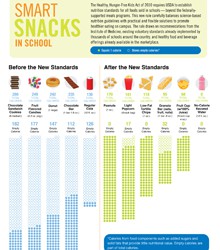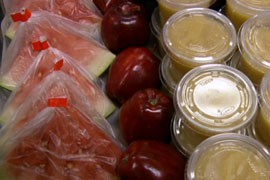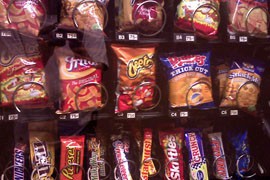Cronkite News has moved to a new home at cronkitenews.azpbs.org. Use this site to search archives from 2011 to May 2015. You can search the new site for current stories.
Arizona ahead of new federal standards on nutritional school snacks
WASHINGTON – The federal government wants to target childhood obesity with new limits for calories, sugar, fat and sodium on snacks sold in the nation’s schools.
The Smart Snacks in School standards, announced last week by the U.S. Department of Agriculture, expand school nutrition standards for the first time to snacks, whether sold in the cafeteria, a vending machine or elsewhere.
Besides setting limits on fats, sugars and calories, the new rules would also limit portion sizes for drinks and snacks. Birthday parties, bake sales and school fundraisers would be exempt from the rules, which are scheduled to go into effect next July.
Most Arizona school officials welcomed the change, saying the state adopted similar nutrition standards for all school foods – including snacks – in 2006.
“Our schools are already ahead of the game,” said Mary Szafranski, deputy associate superintendent for health and nutrition services at the Arizona Department of Education, who said the department supports the new regulations “without a doubt.”
But others worried that there will not be enough time to study the impact of the new rules on students’ diets or to get the new food choices in place. And some local officials worried about the effect of tighter regulations on vending-machine sales, a source of revenue for some schools.
Diane Pratt-Heavner, spokeswoman for the School Nutrition Association, said she thinks schools will do their best to meet the standards, but worries about “the impact that eliminating some of the food options will have on school meal programs participation.”
The association, representing 55,000 school nutrition professionals in schools nationwide, is also concerned that schools might not be able to “provide alternative items that meet the new standard in time.”
“School meal programs are already in the midst of a sea of change as cafeterias work to meet new school breakfast and lunch standards and encourage students to try the healthier choices offered,” said association President Sandra Ford in a statement.
“Complex regulations can present unique challenges and unintended consequences when put into practice,” she said.
Neal McCluskey, an educational analyst at Cato Institute, said one of those consequences could be increasing schools’ financial burden for regulations that he said will not be effective.
“Just because they now stock vending machines with healthy options, it doesn’t mean kids are going to suddenly start eating a lot healthier,” McCluskey said. “Kids will probably throw away the nutritious food and find another way to get snacks, not from vending machines that sell things they don’t want.”
Szafranski disagreed, saying “a hungry child will eat the food that is offered to them.”
When any new food is introduced to a child, said Szafranski, “it may take a couple of times for the child to really start appreciate the taste for it, but I do believe that our children are really adaptable to the positive influence that this will have on them.”
But McCluskey argued that the impact will be “on school revenues and general disuse of the vending machines” and not on students.
Loretta Zullo, director of Mesa Unified School District’s food and nutrition department, said vending-machine sales have decreased in her district since the implementation of the Arizona Nutrition Standards in 2006.
“The dollar sales of vending machines are declining,” Zullo said, adding that they might continue to decline because of the higher standards.
But the Agriculture Department snack regulations note that only about 1.7 percent of “competitive food” revenue came from vending machine sales.
And that is another reason Szafranski backs the new rules. She said the rules will “foster healthy school environments, which should be maintained throughout their lives.”
“It will teach kids about healthful choices, it will teach them about what their body needs nutritiously to grow up to be active, productive, healthful adults,” Szafranski said.
Paradise Valley Unified School District nutrition director Kathy Glindmeier said she has seen a positive effect already under the Arizona standards.
“Kids are used to not having sugary drinks as much,” said Glindmeier, who noted that the most popular drink sold on campuses in the district now is bottled water.
“I think the new rule is important,” she said. “We’ve already made some changes and will continue to make the change we need to make.”










